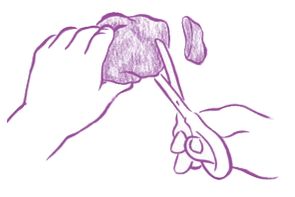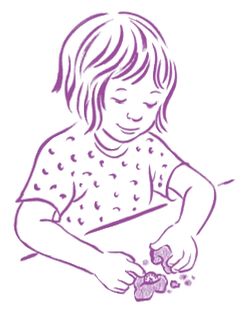Everyday Play (3 page)
Authors: Christy Isbell
Chapter 3
I’m Three! Look What My Hands Can Do!
Your three-year-old child is growing and developing new skills every day! You can use this time of incredible change to nurture your child’s fine motor skills and give her the foundation she needs to eventually learn how to hold a pencil, tie her shoes, and write her name. At three, your child is ready for activities that build strength in her upper body, refine her grasp, and help her learn how to use two hands together (bilateral hand skills).
At age three, your child may be interested in learning how to:
• Copy a circle
• Copy an accurate cross
• Thread large beads
• Build a tower of 10 1” blocks
• Tear paper
• Cut on a straight line
• Build a train with blocks (one block on top and long line behind)
• Copy a square
• Draw and paint with a variety of large tools like paintbrushes and markers)
• Put together simple, three- to four-piece puzzles
• Use glue (with supervision)
• Unbutton large buttons
• Unzip zippers
• Feed herself using a spoon and fork
• Undress and dress with some assistance
Have fun doing the activities on the following pages with your child. They will help her begin to feel confident in her ability to use her hands and will prepare her to try new skills as she gets older.
Marble PaintingDevelops your child’s ability to use two hands together (bilateral hand skills) and improves his eye-hand coordination.
What You Needround, 9” pan or small box without lid | marble | paper | paint | spoon
What to Do• Cut paper to line the bottom of the pan.
• Show your child how to dip a marble into paint with a spoon and then place the marble inside the pan.
• Have him hold the pan with two hands and maneuver it so the marble rolls the paint onto the paper in an interesting pattern.
• Experiment with different-sized marbles and different types of paper.
• See if he can maneuver the pan so that the painted marble leaves a big circle on the paper.
Develops your child’s ability to use two hands together (bilateral hand skills) and helps her learn how to pour liquids.
What You Needclear, plastic lid of pie shell | measuring cup or cup for pouring water | oil | food coloring
What to Do• Give your child a clear, plastic pie-shell lid, and help her use the measuring cup to pour equal parts of water and oil into the plastic lid. The two liquids should just cover the bottom of the lid.
• Let her choose some food coloring and help her drip four or five drops of the food coloring around the plastic lid.
• Show her how to hold the edges of the plate carefully with both hands and move it slowly from side to side.
• Observe how the colorful bubbles move around the plate.
Increases your child’s hand strength and develops your child’s ability to use two hands together (bilateral hand skills)
What You Needtoy hammers, screwdrivers, and mallets | large nuts and bolts that fit together | small pieces of PVC pipe and connectors | heavy-duty plastic or wooden toys | broken toys
What to Do• As you play with your child, show him how to use the tools and how to put various materials like nuts and bolts together.
• Have fun building new toys or “repairing” broken toys.
• Add an empty toolbox to give your child more opportunities to sort tools and materials.
Develops the foundations for your child’s fine motor skills and increases her upper-body strength
What You Needlarge sheets of paper | tape (recommended) | cardboard or other hard surface to write on (if doing the activity on carpet) | large markers, crayons, and/or paintbrushes
What to Do• Clear some space so your child can spread out on the floor. If you are using a carpeted area, make sure you have a length of cardboard or some other hard material that she can use for a drawing surface.
• If you can, tape the paper to the floor or cardboard.
• Give her markers, crayons, and other drawing tools, and invite her to lie down on her stomach to create her masterpiece. Offer small pillows or blankets for her to put under her elbows to keep her comfortable on the hard floor.
• Try this activity outdoors to inspire your child to draw pictures of nature.
Develops your child’s finger strength
What You Needpieces of Styrofoam | duct or packing tape | golf tees | toy hammers or small mallets
What to Do• To control a potentially messy situation, cover the outside edges of the Styrofoam with tape.
• Encourage your child to use the hammers and mallets to build something with the Styrofoam and golf tees.
• Demonstrate how he can push golf tees into the Styrofoam with his fingers and with the hammer.
Safety Note:
Always observe closely to ensure your child uses the hammer and golf tees safely.
Always observe closely to ensure your child uses the hammer and golf tees safely.
• Give your child large markers so he can decorate his building.
• Ask him to see how tall he can build his Styrofoam building.
Enhances your child’s pincer grasp and improves her eye-hand coordination
What You NeedIndian corn | large plastic container | sand toys, such as small buckets and shovels, plastic spoons, and large funnels
What to Do• Put the Indian corn in a plastic container and show your child how to “pick” the corn kernels off the ears.
• After she removes all of the corn kernels, she can have fun using the sand toys and her fingers to scoop and pour the kernels.
• Encourage her to try to pick up individual kernels, which will help her improve her pincer grasp—an important pre-writing skill.
• Add small plastic bottles, such as medicine bottles or travel-size bottles, to the bucket. Show your child how to fill the bottles with kernels, put on the lids, and use them as shakers.
Improves your child’s grasp strength
What You Needturkey basters and eyedroppers | sponges in a variety of sizes, such as makeup sponges, kitchen sponges, natural sponges, or large cleaning sponges | large plastic container with water | plastic cups and bottles
What to Do• Show your child how to fill turkey basters, eyedroppers, and sponges with water. Encourage him to fill up cups or bottles, dump out the water, and fill them up again.
• Add liquid soap to the water to add a new dimension to the activity.
• To really focus on his pincer grasp, cut the sponges into small 1”-2” pieces.
Improves your child’s grasp and increases finger strength
What You Needpaper | variety of stamps with small handles | washable inkpads | large washable markers
What to Do• Give your child paper, stamps, and inkpads and show her how to use them.
• When she is interested, show her how to use a marker to color the stamp rather than using the inkpad.
• Encourage her to explore different methods of using stamps to make art.
• Talk with your child about her creations.
• Make soap stamps by cutting small pieces of soap in half and carving out shapes or designs (adult only). Ink will adhere to most soap, but Ivory® soap works well.
Refines your child’s grasp and helps develop his proper forearm posture and wrist positioning
What You Needfelt board and small felt pieces | magnetic board and small magnetic pieces such as shapes, animals, or letters | easel with tray or wall
What to Do• Place the magnetic board or felt board in a vertical position by putting it on an easel or propping it securely against a wall.
• Encourage your child to play with the magnetic pieces on the vertical board. Ask him to make up a story with the animals or build a tower out of the different shapes. This will help him develop appropriate forearm and wrist positioning and grasp.
• Read a story and ask your child to pick appropriate pieces and use them to re-enact the story on the vertical board.
Improves your child’s grasp of small objects and strengthens her eye-hand coordination
What You Needmini-muffin pans | small items to sort, such as buttons, tiny pegs, stones, marbles, coins, or paper clips
What to Do• Set out the various small items and challenge your child to sort the items into matching groups and place each group into a different mini-muffin cup (for example, putting all marbles together).
• Sort the objects using other criteria, such as color, shape, or weight.
• Help your child count the number of objects inside one muffin hole.
Develops your child’s hand strength and
improves finger coordination
What You Needimproves finger coordination
playdough | small objects, such as marbles, coins, pegs, or animals
What to Do• Set out the playdough and small objects to explore.
• Hide a few of the objects inside some of the playdough, and invite your child to find them.

• Place small cups at the table. Ask your child to place each object she finds inside the playdough into a small cup. Then help her count how many objects she found.
• Invite her to close her eyes and try to find the objects hidden in the playdough using only her fingers.
• Cutting playdough improves hand strength, so give your child scissors and encourage her to cut the playdough into pieces.


Improves your child’s hand strength and enhances her fine motor coordination
What You Needlarge bowl and a spoon for mixing (Note: Sand may scratch the bowl during mixing.) | 1 cup sand | 1 package Jell-O® sugar-free gelatin | ½ cup cornstarch | ¾ cup hot water | 1 tsp alum (found in the spice aisle of your grocery store) | food coloring
Note
: Double the recipe if you want to do the activity below in More Fun!
What to Do: Double the recipe if you want to do the activity below in More Fun!
• Mix all the ingredients together in a large bowl (adult-only step).
• Allow the clay to cool (adult-only step), and then knead it.
• Encourage your child to mold sand castles with her hands.
• Observe how your child uses her hands to manipulate the clay.
• Provide sand tools, such as small hand-held shovels, buckets, or craft sticks, and small shells for decorating castles.
Develops your child’s pre-scissor skills
What You NeedOther books
Overexposed: The Complete Boxset: A Virgin Meets a Bad Boy Romance by Rae Lynn Blaise
More Than Willing by Laura Landon
The Battered Body by J. B. Stanley
English Rider by Bonnie Bryant
Mate Claimed by Jennifer Ashley
Girls Don't Have Cooties by Nancy E. Krulik
Turn Us Again by Charlotte Mendel
The Secret Eleanor by Cecelia Holland
Wicked Obsessions by Marilyn Campbell
The Georges and the Jewels by Jane Smiley